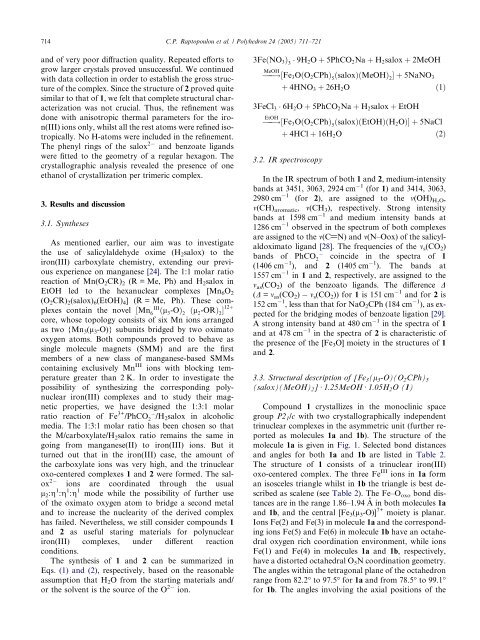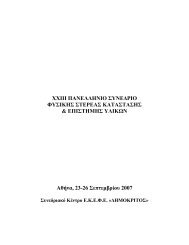Salicylaldoxime (H2salox) in iron(III) carboxylate chemistry ...
Salicylaldoxime (H2salox) in iron(III) carboxylate chemistry ...
Salicylaldoxime (H2salox) in iron(III) carboxylate chemistry ...
Create successful ePaper yourself
Turn your PDF publications into a flip-book with our unique Google optimized e-Paper software.
714 C.P. Raptopoulou et al. / Polyhedron 24 (2005) 711–721and of very poor diffraction quality. Repeated efforts togrow larger crystals proved unsuccessful. We cont<strong>in</strong>uedwith data collection <strong>in</strong> order to establish the gross structureof the complex. S<strong>in</strong>ce the structure of 2 proved quitesimilar to that of 1, we felt that complete structural characterizationwas not crucial. Thus, the ref<strong>in</strong>ement wasdone with anisotropic thermal parameters for the <strong>iron</strong>(<strong>III</strong>)ions only, whilst all the rest atoms were ref<strong>in</strong>ed isotropically.No H-atoms were <strong>in</strong>cluded <strong>in</strong> the ref<strong>in</strong>ement.The phenyl r<strong>in</strong>gs of the salox 2 and benzoate ligandswere fitted to the geometry of a regular hexagon. Thecrystallographic analysis revealed the presence of oneethanol of crystallization per trimeric complex.3. Results and discussion3.1. SynthesesAs mentioned earlier, our aim was to <strong>in</strong>vestigatethe use of salicylaldehyde oxime (H 2 salox) to the<strong>iron</strong>(<strong>III</strong>) <strong>carboxylate</strong> <strong>chemistry</strong>, extend<strong>in</strong>g our previousexperience on manganese [24]. The 1:1 molar ratioreaction of Mn(O 2 CR) 2 (R = Me, Ph) and H 2 salox <strong>in</strong>EtOH led to the hexanuclear complexes [Mn 6 O 2(O 2 CR) 2 (salox) 6 (EtOH) 4 ] (R = Me, Ph). These complexesconta<strong>in</strong> the novel ½Mn <strong>III</strong> 6ðl 3 -OÞ 2ðl 2 -ORÞ 2Š 12þcore, whose topology consists of six Mn ions arrangedas two {Mn 3 (l 3 -O)} subunits bridged by two oximatooxygen atoms. Both compounds proved to behave ass<strong>in</strong>gle molecule magnets (SMM) and are the firstmembers of a new class of manganese-based SMMsconta<strong>in</strong><strong>in</strong>g exclusively Mn <strong>III</strong> ions with block<strong>in</strong>g temperaturegreater than 2 K. In order to <strong>in</strong>vestigate thepossibility of synthesiz<strong>in</strong>g the correspond<strong>in</strong>g polynuclear<strong>iron</strong>(<strong>III</strong>) complexes and to study their magneticproperties, we have designed the 1:3:1 molarratio reaction of Fe 3+ /PhCO 2/H 2 salox <strong>in</strong> alcoholicmedia. The 1:3:1 molar ratio has been chosen so thatthe M/<strong>carboxylate</strong>/H 2 salox ratio rema<strong>in</strong>s the same <strong>in</strong>go<strong>in</strong>g from manganese(II) to <strong>iron</strong>(<strong>III</strong>) ions. But itturned out that <strong>in</strong> the <strong>iron</strong>(<strong>III</strong>) case, the amount ofthe <strong>carboxylate</strong> ions was very high, and the tr<strong>in</strong>uclearoxo-centered complexes 1 and 2 were formed. The salox2 ions are coord<strong>in</strong>ated through the usuall 2 :g 1 :g 1 :g 1 mode while the possibility of further useof the oximato oxygen atom to bridge a second metaland to <strong>in</strong>crease the nuclearity of the derived complexhas failed. Nevertheless, we still consider compounds 1and 2 as useful star<strong>in</strong>g materials for polynuclear<strong>iron</strong>(<strong>III</strong>) complexes, under different reactionconditions.The synthesis of 1 and 2 can be summarized <strong>in</strong>Eqs. (1) and (2), respectively, based on the reasonableassumption that H 2 O from the start<strong>in</strong>g materials and/or the solvent is the source of the O 2 ion.3FeðNO 3 Þ 3 9H 2 O þ 5PhCO 2 Na þ H 2 salox þ 2MeOHMeOHƒ ƒ! ½Fe3 OðO 2 CPhÞ 5ðsaloxÞðMeOHÞ 2Šþ5NaNO 3þ 4HNO 3 þ 26H 2 Oð1Þ3FeCl 3 6H 2 O þ 5PhCO 2 Na þ H 2 salox þ EtOHƒ EtOH ƒ! ½Fe 3 OðO 2 CPhÞ 5ðsaloxÞðEtOHÞðH 2 OÞŠ þ 5NaClþ 4HCl þ 16H 2 Oð2Þ3.2. IR spectroscopyIn the IR spectrum of both 1 and 2, medium-<strong>in</strong>tensitybands at 3451, 3063, 2924 cm 1 (for 1) and 3414, 3063,2980 cm 1 (for 2), are assigned to the m(OH) H2 O,m(CH) aromatic , m(CH 3 ), respectively. Strong <strong>in</strong>tensitybands at 1598 cm 1 and medium <strong>in</strong>tensity bands at1286 cm 1 observed <strong>in</strong> the spectrum of both complexesare assigned to the m(C@N) and m(N–Oox) of the salicylaldoximatoligand [28]. The frequencies of the m s (CO 2 )bands of PhCO 2co<strong>in</strong>cide <strong>in</strong> the spectra of 1(1406 cm 1 ), and 2 (1405 cm 1 ). The bands at1557 cm 1 <strong>in</strong> 1 and 2, respectively, are assigned to them as (CO 2 ) of the benzoato ligands. The difference D(D = m as (CO 2 ) m s (CO 2 )) for 1 is 151 cm 1 and for 2 is152 cm 1 , less than that for NaO 2 CPh (184 cm 1 ), as expectedfor the bridg<strong>in</strong>g modes of benzoate ligation [29].A strong <strong>in</strong>tensity band at 480 cm 1 <strong>in</strong> the spectra of 1and at 478 cm 1 <strong>in</strong> the spectra of 2 is characteristic ofthe presence of the [Fe 3 O] moiety <strong>in</strong> the structures of 1and 2.3.3. Structural description of [Fe 3 (l 3 -O)(O 2 CPh) 5(salox)(MeOH) 2 ] Æ 1.25MeOH Æ 1.05H 2 O(1)Compound 1 crystallizes <strong>in</strong> the monocl<strong>in</strong>ic spacegroup P2 1 /c with two crystallographically <strong>in</strong>dependenttr<strong>in</strong>uclear complexes <strong>in</strong> the asymmetric unit (further reportedas molecules 1a and 1b). The structure of themolecule 1a is given <strong>in</strong> Fig. 1. Selected bond distancesand angles for both 1a and 1b are listed <strong>in</strong> Table 2.The structure of 1 consists of a tr<strong>in</strong>uclear <strong>iron</strong>(<strong>III</strong>)oxo-centered complex. The three Fe <strong>III</strong> ions <strong>in</strong> 1a forman isosceles triangle whilst <strong>in</strong> 1b the triangle is best describedas scalene (see Table 2). The Fe–O oxo bond distancesare <strong>in</strong> the range 1.86–1.94 Å <strong>in</strong> both molecules 1aand 1b, and the central [Fe 3 (l 3 -O)] 7+ moiety is planar.Ions Fe(2) and Fe(3) <strong>in</strong> molecule 1a and the correspond<strong>in</strong>gions Fe(5) and Fe(6) <strong>in</strong> molecule 1b have an octahedraloxygen rich coord<strong>in</strong>ation env<strong>iron</strong>ment, while ionsFe(1) and Fe(4) <strong>in</strong> molecules 1a and 1b, respectively,have a distorted octahedral O 5 N coord<strong>in</strong>ation geometry.The angles with<strong>in</strong> the tetragonal plane of the octahedronrange from 82.2° to 97.5° for 1a and from 78.5° to 99.1°for 1b. The angles <strong>in</strong>volv<strong>in</strong>g the axial positions of the
















